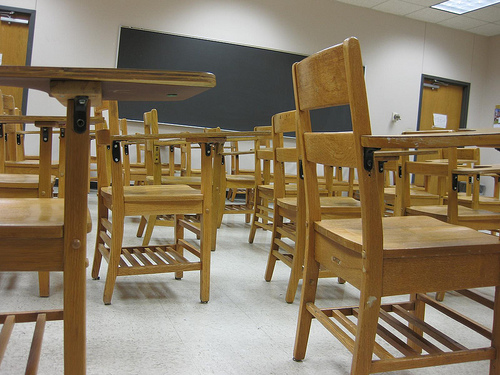Creating Honest and Authentic Education: Inviting Economy to the Table
On September 16, 2010 the Sacramento Bee reported on a connection between California’s newly published environmental curriculum and British Petroleum. The article, “BP Aids State’s Schools Content,” stated that BP had been one of a few for-profit entities that worked over the course of 7 years to create 13,000 pages of curriculum. Environmental groups and educators alike were crying foul over the participation of a huge oil conglomerate, especially in light of April 20th’s massive spill. The irony and outrage surfaced quickly on the pages of the Sacramento paper as people asked how BP found a place in creating curriculum that would connect the natural resource that they extract, at what seems like any cost to the environment, with a fundamental understanding of healthy ecosystems for California’s students.
After speaking with Kirk Amato with the Environment and Education Initiative (EEI), it became less clear how exactly BP participated in the process. Amato stated that while a BP scientist had sat in on one meeting 4-5 years ago, that was the extent of the relationship. The press release sent out in response to the Bee article stated that while the curriculum is designed to be without bias, “perspectives of industries that impact our California environment and economy are critical to engage and involve.”
As one of the PDX 2 Gulf Coast’s science teachers, I decided to take a look at the curriculum, and to be honest, it was pretty factual and non-persuasive, a decent reflection of the issues and debate center to the carbon debate. Ultimately, whether the curriculum is in final form or whether it carries a meaningful enough impact to affect California’s learners will be determined with time, as it is piloted in 20 or so districts starting this school year.
But what I’m left to struggle with is whether I believe that having oil tycoon BP at the table would be a true “conflict of interest” – is it a way for BP to yield its mighty sword and brainwash California’s young people into thinking that the company behind the green and yellow logo was extremely concerned about and careful with the environment when we know their history proves otherwise?
BP’s motives leave me without struggle – those are obvious. It would take a great deal of convincing for me to believe that working to develop authentic, dynamic environmental education is at all a part of their mission statement. But, I can get behind the EEI committee’s decision to invite for-profit energy power players to engage in the undertaking.
As a high school teacher, when I expose my Northwest Ecology students to forest ecology, the epitome of the unit is the six hours we spend in a luscious, dank, oozing old growth forest bursting with life and biological processes hundredfold in every inch of biomass. We learn about the organisms that depend solely on the health of old growth forests and the characteristics and life cycle of this complex and disappearing place on earth. But, I learned long ago that I was only painting half the picture for them – the Portland “tree hugger” side – if I left it there and drove them back home. Young and old alike must understand that the reality of living on a planet with six billion people is that we extract those same natural resources that John Muir and Gifford Pinchot worked to preserve at the turn of the last century.
So, after sleeping on a gymnasium floor in a blue-collar Washington town, we wake up to spend a few hours with the local timbermen. We work hard to check our judgments, stereotypes, and hipster attitudes at the mill door but there are usually only a few minutes that pass before a question is asked by one of my clan that prompts the response, “Uh oh, boys, you can tell we have the Oregonians in the house.”
But, what happens in the next two hours is that we see these men for more than our misperceptions. Some of us shed a small piece of our belief systems where we think of woodsmen as ignorant, uneducated dudes that can’t find anything else for work, so they settle for the mill. We also hear from them that they are not harvesting old growth, they have to replant and that they do recognize, whether because they’re forced by environmental regulation or tethered to a moral compass, the need to operate responsibly in our natural areas.
What happens over the next two months is of more long-term importance – we dive into the economy behind the extraction of trees as we painfully evaluate how many ways we intersect with downed logs in every day of our advanced lives. This last winter, my juniors and seniors were especially entertained by a bumper sticker on a beat-up, old pick up truck: “Don’t like loggers? Try wiping your ass with tinfoil.” We start the unit by placing ourselves along a continuum that has ecology/preserve at one end – the philosophy that John Muir championed – that we leave our natural areas untouched, that they are a place we go to get in touch with our spiritual selves and economy/consume at the other – which I describe as reckless removal of resources for extreme profit. No student at this particular local high school would ever place themselves too far from ecology in the beginning – if for no other reason than their tree-huggin’-environmental-middle-school-liberal-hipster neighbor might start talking about them in the hall.
By the end of the unit, the vast majority of students have moved themselves more toward the economy camp – not because they want to cut more board feet of the Pacific Northwest’s trees, but because they have begun to recognize the reality of survival in a world of natural resources. There is an element of conjuring up awareness, responsibility and movement toward at least thinking of alternatives.
Remove trees, insert oil. The impact of the petroleum industry is not directly felt in the Northwest, like the debate around trees is not felt by students in urban Louisiana. But, I find myself believing that whatever it is that is being extracted, if educators are going to create honest and authentic lessons around environmental education, you have to set a place for “economy” at the table, and send them an invite. And if we’re going to be really honest, we will discuss these issues in a way that pulls kids – well, all of us, really, regardless of age – to a place where we realize that the conglomerate “bad guys” wouldn’t exist if we didn’t live lifestyles that demanded that our planet’s resources were withdrawn at mind-blowing rates. It’s only then that we will have the power to change – starting with recognition that it’s not us versus them, we are all in this environmental mess together and we’re going to have to collaborate to get out.
By Serena Talcott Baughman
Image: alamosbasement
























1 COMMENT
Yeah, most of the individuals working in the lumber industry, just like the individuals in the oil industry, are not to blame. Lets distinguish between the individual, and the institution which carries out a practice underpinned by particular philo…sophies and policies. The form within which natural resource extraction takes place is important to take into account before jumping to the dichotomous decision between “good” and “bad”. Massive, bulldozer-led clear-cuts are destructive: They violently interrupt biological activity, they cause a large amount of emissions that are not accounted for in finance, or in practice, and they are only necessary to an industrial system that places profit above health as a priority. Selective cutting works.
The head ranger of the Hood River district of the U.S. Forest Service meets her federally-mandated annual boardfeet requirements with selective logging. She has family-owned logging businesses (some of which are horse-driven, much easier on the flora, fauna, and soil than a D10 Bulldozer that weighs 175,000 lbs) come in to remove the invasive white pine, which grows in height at rate that allows forest fires to climb up to the elevation where they can set old-growth on fire. Old-growth, because of its developed structure, is actually fairly resistant to forest fires if the forest is maintained properly by humans, like the Native Americans used to: remove the fast-growing young trees for wood resource, leave the old growth to anchor a healthy ecosystem.
Lets be critical. Hearing different sides of the story is positive. We also need to look at claims of “good” and “bad”, “right” and “wrong” in relation to the facts of the ecological system being impacted, and the alternative practices that do and could exist.
Same thing with oil. Not all drilling is bad, but some is worse than others. The sand-shale drilling in Canada consumes 3 barrels of oil for every barrel extracted. Doesn’t add up. Doesn’t pay for itself in terms of energy, the extraction process isn’t clean, it isn’t economically viable in the long-term. I would call this a bad practice. BP telling the rig operators on Deep Horizon to keep drilling after pieces of the blowout preventer come up with the hydraulic fluid that regulates pressure along the drill shaft: criminally negligible practice. People need to make a living. People don’t need to make a living risking other people’s, and the local ecosystem’s livelihoods.
I understand that BP being brought to the table could be considered a good practice from the perspective that multiple viewpoints offer a greater opportunity for a more dynamic, complex, and educational curriculum. Their intentions are definitely questionable, and so is the practice of inviting them to the table without making a genuine effort to inform the public that pays the taxes to buy these books.
Leave a comment